Today, Micron launched the new 6550 ION SSD, positioning it as the “world’s fastest, most energy-efficient 60TB data center SSD.” Available in various form factors, the triumph is the E3.S drive, which, at just 7.5mm in z-height, offers an industry-leading drive capacity using G8 61.44TB of TLC NAND, paired with a Gen5 interface. This combo solves critical enterprise challenges that demand extremely dense, affordable, and fast SSD storage.
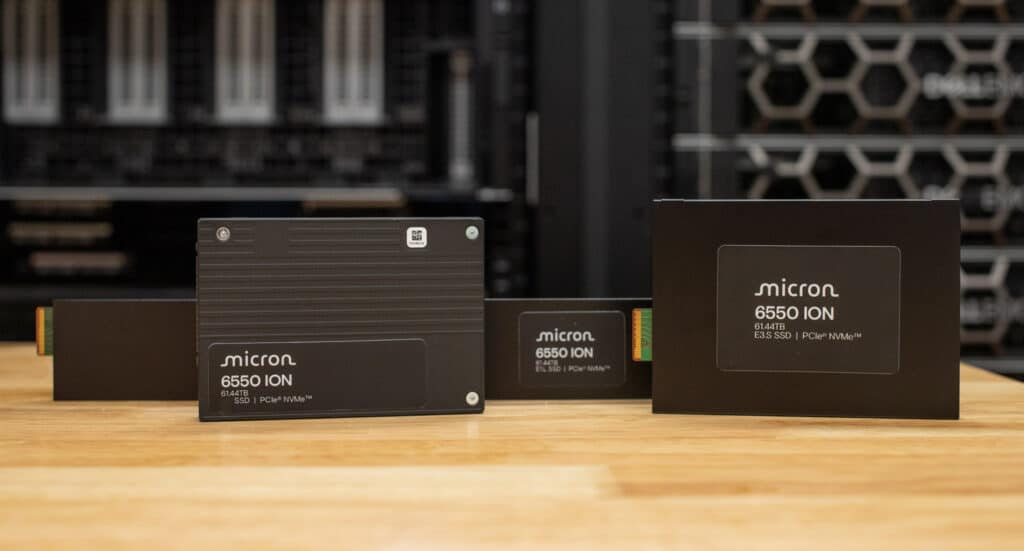
The Micron 6550 ION offers massive performance and capacity benefits over the 6500 ION, its predecessor. It adheres to PCIe Gen5 standards and incorporates future-proofing capabilities through OCP 2.5. Micron has prioritized security in the 6550 ION, ensuring TAA and FIPS 140-3 L2 certifiability and a comprehensive security suite.
Before releasing the TLC-based Micron 6550 ION, manufacturers needed to use QLC NAND to hit the 61.44TB capacity point. Besides the newer Gen5 interface, G8 TLC NAND offers better write performance, energy efficiency, and endurance than QLC NAND. From a performance perspective, the drive hits sequential read speeds of 12GB/s and sequential write speeds of 5GB/s using only 20W maximum. These figures translate into up to 179% superior read throughput compared to competitors and up to 150% enhanced write throughput. Regarding write speed, the fill rate of the 61.44TB Micron 6550 ION is just 3.4 hours. Furthermore, the Micron 6550 ION demonstrates impressive throughput capabilities, reaching 1.6M IOPS in 4K random reads, up to 80% faster than current competitors.
While we’re enthused mainly by the density gains in the E3.S form factor, it’s well worth pointing out that Micron offers the 6550 ION in E1.L and U.2 form factors. This allows for a wide variety of platforms to be supported, with no compromise on feature set or performance capabilities within the family.
Gen5: A First for High-Capacity NVMe SSDs
There is a lot to love about the Micron 6550 ION SSD family. Probably the most important is that this is the highest-capacity Gen5 drive to hit the market. PCIe Gen5 offers significant advancements over PCIe Gen4, primarily in terms of bandwidth, data transfer speed, and energy efficiency—key improvements that meet the growing demands of modern data-intensive applications.
Overall, PCIe Gen5 brings substantial performance, speed, efficiency, and scalability benefits over Gen4. It is ideal for advanced data center needs and high-performance computing where rapid data throughput and low latency are essential—especially for most workloads that tend to be read-heavy. As this is the first high-capacity PCIe Gen5 drive, the Micron 6550 ION has a significant advantage over competing models still operating on PCIe Gen4.
Energy Efficient
Energy efficiency plays a crucial role in the value of SSDs in data centers, and the Micron 6550 ION impresses. SSDs consume less power and generate less heat, contributing to reduced energy consumption and cooling requirements. This leads to significant cost savings and a smaller carbon footprint, aligning with sustainability goals. Considered best-in-class 60TB energy efficiency, the Micron 6550 ION uses up to 20% less power than the competition while delivering significantly more performance.
NVMe drives support multiple operational power states that balance performance and power consumption. Micron conducted all tests at Power State 1 (PS1), which limits the drive to 20w instead of the maximum 25w. The drives also support L1 ASPM (Active State Power Management), reducing idle power consumption even more.
The Micron 6550 ION power/performance benchmarks are impressive. The Micron 6550 ION boasts sequential reads of 600MB/s/W, up to 179% better than competitors, and sequential writes of 250MB/s/W, exceeding the competition by 213%. Random reads (80KIOPS/W) and writes (3.5KIOPS/W) are just as remarkable. The competition lags by up to 99% and 141%, respectively.
By increasing the energy efficiency of SSDs, data centers can maintain high performance while optimizing operational costs.
Micron 6550 ION SSD Drive Design
The Micron 6550 ION SSD is the first 61.44TB E3.S-1T SSD, storing up to 67% more per rack than U.2 61.44TB SSDs. The thin 7.5mm E3.S-1T thickness has been elusive, up until now, for the current crop of high-capacity enterprise SSDs. Many are on the E1.L or U.2 form factor, which offers more internal surface area for NAND chips and other components. The 15mm U.2 shape for some competing drives includes a twin PCB layout connected internally, offering twice the surface area of a single circuit board. That worked when you could leverage the additional thickness, but it can’t be translated to thinner SSD sizes.
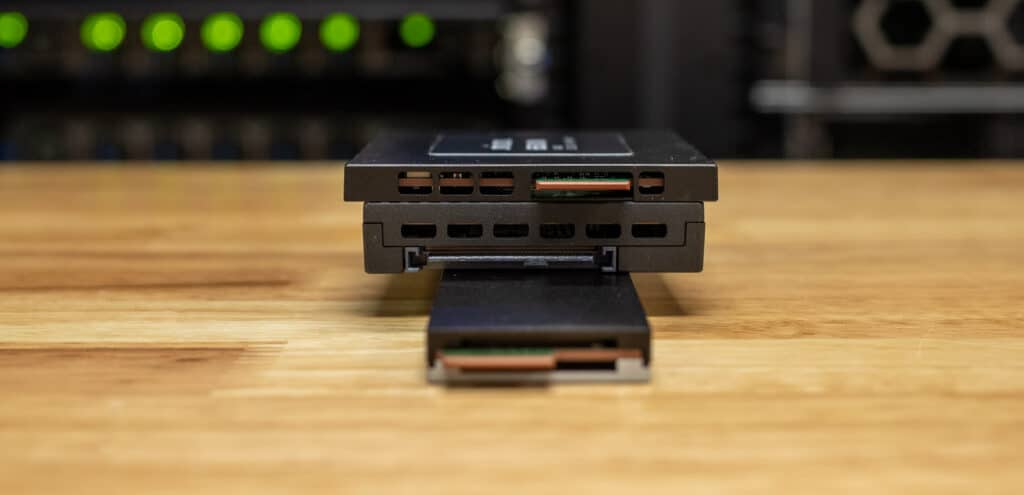
The difficulty in achieving greater densities in the E3.S form factor comes down to a few key challenges:
- Physical Space Constraints: The E3.S form factor is optimized for better airflow and thermal management compared to traditional 2.5-inch drives. Internal space for the E3.S is limited. This makes fitting more NAND flash packages and necessary control circuitry challenging without sacrificing heat management or performance.
- Thermal Management: High-density SSDs generate more heat, making dissipating in a compact form factor difficult. Effective heat dissipation is critical to maintaining performance and avoiding throttling, so balancing density with thermal solutions is a significant challenge.
- Power Consumption: As capacity increases, power requirements can also increase. Designing an E3.S drive that can support high capacity while staying within acceptable power and cooling limits for data center racks can be complicated.
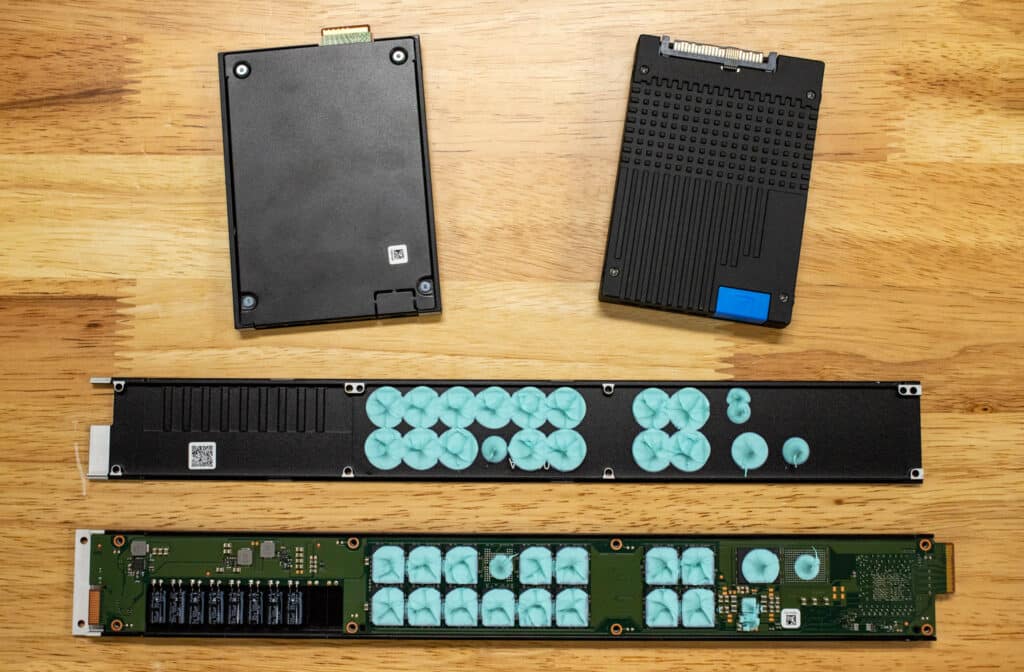
While the E3.S drive stands out for its capacity and thin body, Micron offers an E1.L and U.2 drive. These form factors greatly expand Micron’s addressable market, servicing more traditional enterprise servers with U.2 bays and hyperscalers with E1.L. All drives feature a vertically integrated design, with Micron DRAM, NAND, controller, and in-house firmware stack.
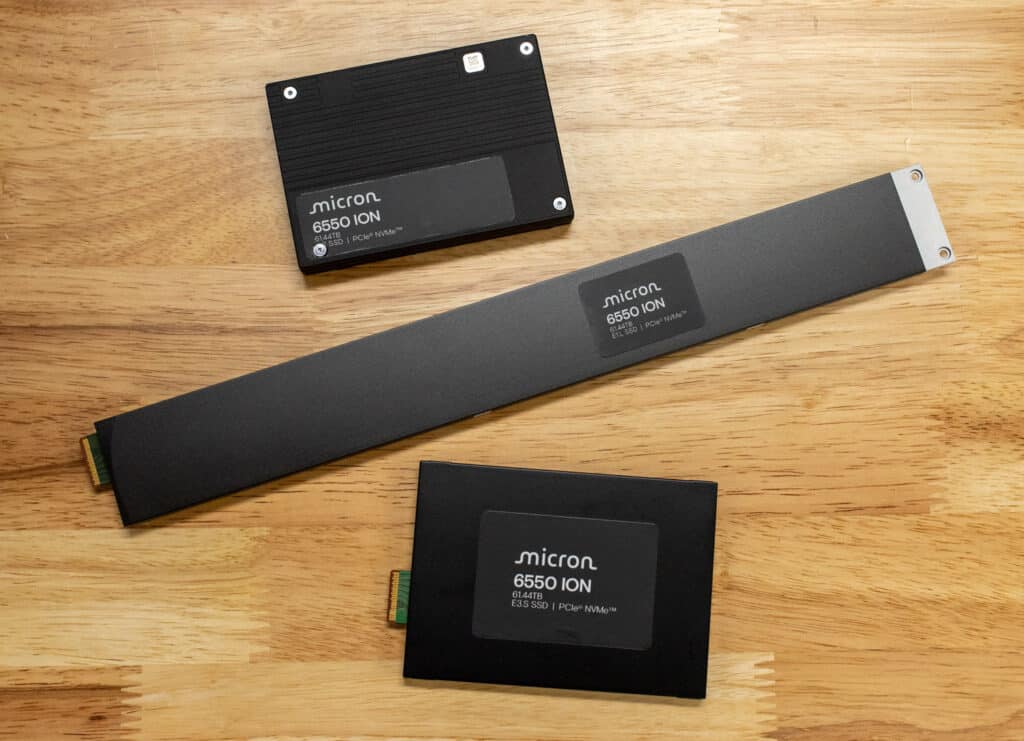
Micron 6550 ION SSD Specifications
| Feature | Details |
| Technology | Micron G8 TLC NAND | PCIe Gen5 1×4 NVMe(v2.0b) |
| Form Factors | E3.S-1T (7.5mm), U.2 (15mm), E1.L (9.5mm) |
| Capacities | 30.72TB – 61.44TB (same performance specs for all SKUs) |
| 128K Seq Reads, QD128 | 12,000 MB/s |
| 128K Seq Writes, QD128 | 5,000 MB/s |
| 4K Random Reads, QD512 | 1,600,000 IOPS |
| 4K Random Writes, QD128 | 70,000 IOPS |
| Endurance (for 5-year warranty) |
|
| Power |
|
| Reliability
(UBER = uncorrectable bit error rate) |
|
| Features |
|
| Warranty | 5 years |
Micron 6550 ION Synthetic Performance Validation
With the Micron 6550 ION in the StorageReview Lab, we put the U.2 version of the drive through the paces inside a Dell PowerEdge R760 test platform. Micron included figures they measured in their lab, which we could validate in our testing, alongside the QLC-based Solidigm P5336 61.44TB SSD, the only widely shipping SSD available at this capacity point.
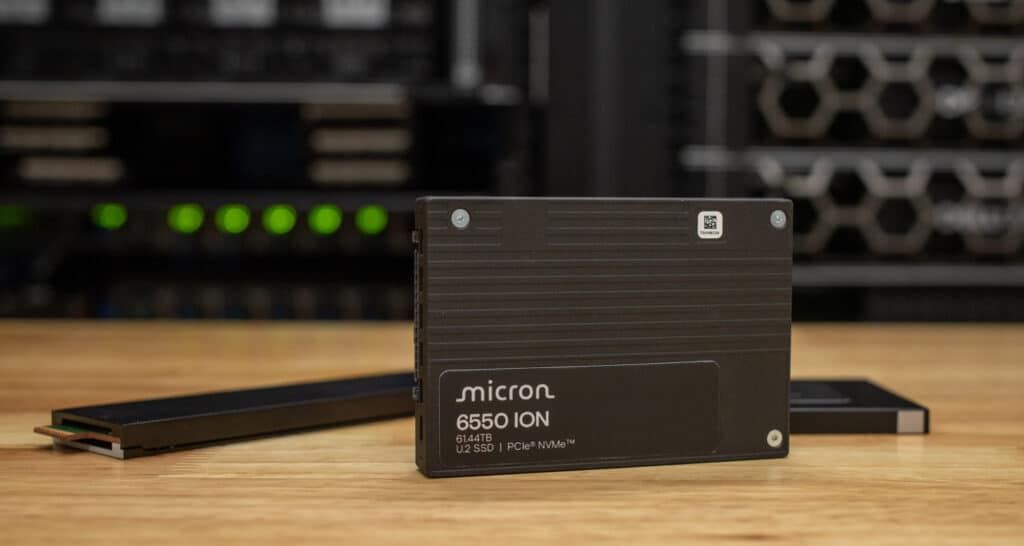
Along with the performance validation we performed on the Micron 6550 ION, we tested the power states to restrict the power consumed by the Micron 6550 ION. While all NVMe devices can be operated unrestricted (consuming up to 25W of power), NVMe SSDs support lowering the peak usage to save on power draw. Reducing power can significantly impact performance for some drives, but the Micron 6550 ION is optimized for lower power draw, offering data center performance within a smaller power envelope.
Before we started our performance tests, we put the Micron 6550 ION in PS1 mode and left the Solidigm P5335 in PS0 mode or unrestricted. The Micron 6550 ION supports eight power states (PS0 to PS7), which range from 25W max down to just 10W on the lower end. PS1 sets the maximum power draw on this SSD to 20W. By comparison, the Solidigm P5336 supports three power states (PS0 to PS2), which range from 25W to 10W in 5-10W increments.
Each SSD was put through a 128K sequential precondition workload for this performance comparison, where the drives were filled twice. When the precondition finished, the drives were tested for 128K sequential read and write performance while in the preconditioned state. The workload was then switched to a 16K random precondition for two drive fills, and the remaining 16K read and write tests were completed.
| Block Size | Operation | Micron Average Power Draw at Power State PS1 | FIO Workload Thread/Queue | Expected Micron 6550 ION Performance | Measured Micron 6550 ION Performance | Measured Solidigm P5336 Performance |
|---|---|---|---|---|---|---|
| 16KB | Random Read | 17.9 W | 8T/256Q | > 700k IOPs > 11.2 GB/s |
11.6GB/s 707k IOPs |
7.4GB/s 454k IOPs |
| 16KB | Random Write | 17.5 W | 2T/1Q | > 70k IOPs > 1.1 GB/s |
1.4GB/s 85.4k IOPs |
850MB/s 51.9k IOPs |
| 128KB | Sequential Read | 17.5 W | 1T/64Q | > 12 GB/s | 12.7GB/s | 7.5GB/s |
| 128KB | Sequential Write | 17.5 W | 1T/16Q | > 5 GB/s | 8.2GB/s | 3.2GB/s |
The Micron 6550 ION in our lab maintained alignment with the quoted Micron 6550 ION performance and, in some cases, exceeded Micron’s spec sheet.
In our 16K random read workload, the Micron 6550 ION maintained 11.6GB/s, compared to 7.4GB/s from the Solidigm P5536. In steady-state in the 16K random write workload, the Micron 6550 ION could offer 1.4GB/s, over 850MB/s from the P5336. Moving up to the 128K sequential read workload, the Micron 6550 ION measured 12.7GB/s, compared to 7.5GB/s from the Solidigm P5336. Switching to 128K sequential write, the Micron 6550 ION measured 8.2GB/s versus 3.2GB/s from the Solidigm P5336.
Comparing it to the Solidigm P5336, we noted many areas where the newer Gen5 interface on the Micron 6550 ION excelled over the Gen4 interface in the P5336, which is expected. The difference between Gen4 vs. Gen5 drives relates to how much bandwidth each drive can push across the wire. The Gen4 PCIe interface with four lanes of connectivity is capable of around 7GB/s, while the newer Gen5 PCI interface doubles that with 14GB/s. Micron’s use of TLC NAND gives it another design advantage over QLC-based competitors.
Micron 6550 ION AI Workload Performance
AI workloads have put a strain on administrators by demanding high-performing servers and superior energy efficiency. Micron positioned the 6550 ION against the Solidigm P5336 to showcase its capabilities using four distinct workloads: NVIDIA(R) Magnum IO(TM), Unet3D training and capture, and AI model checkpointing. The GPUDirect Storage (GDS) tests enable direct data transfer between storage and GPUs by bypassing CPU memory and reducing data movement overhead and latency.
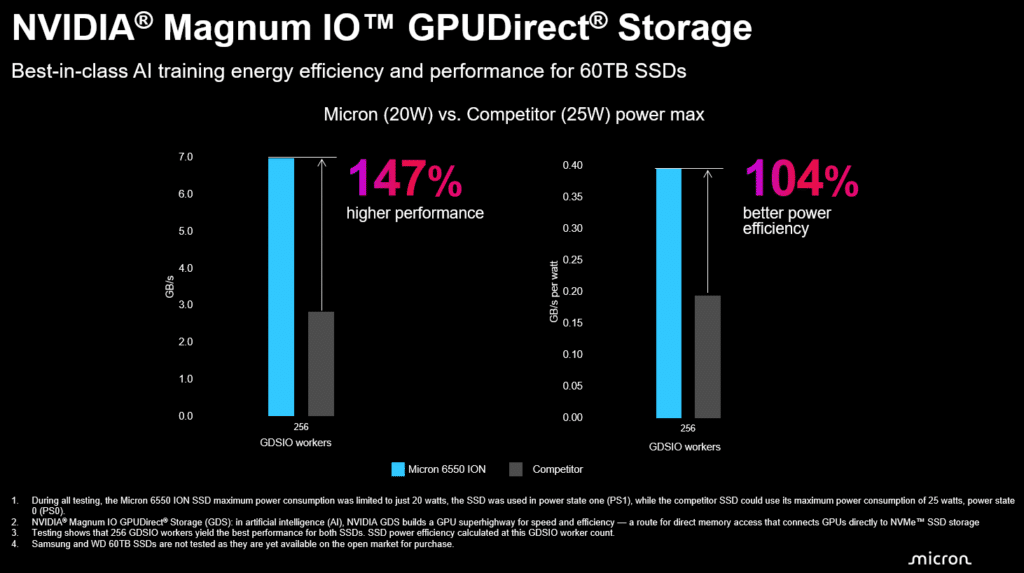
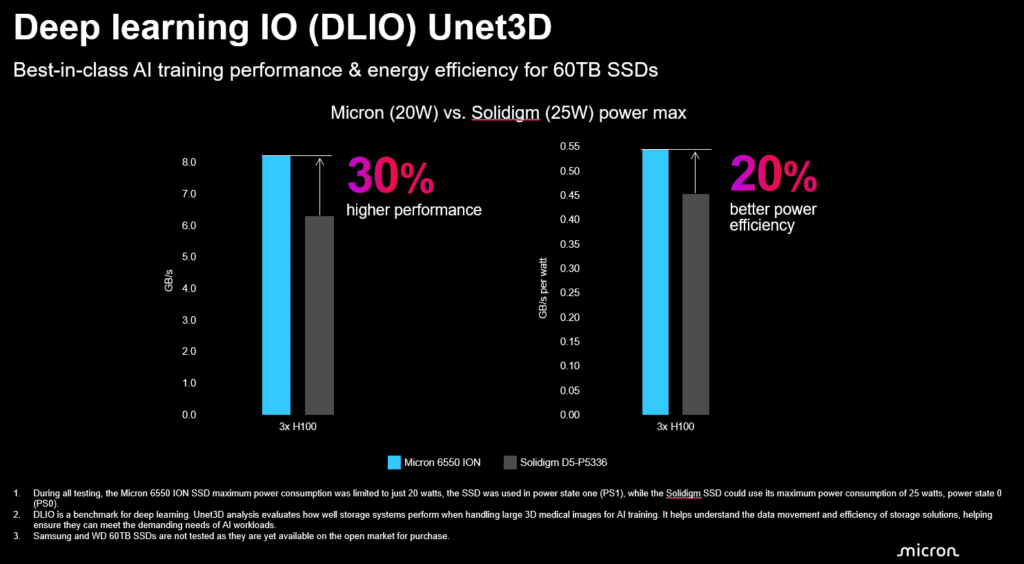
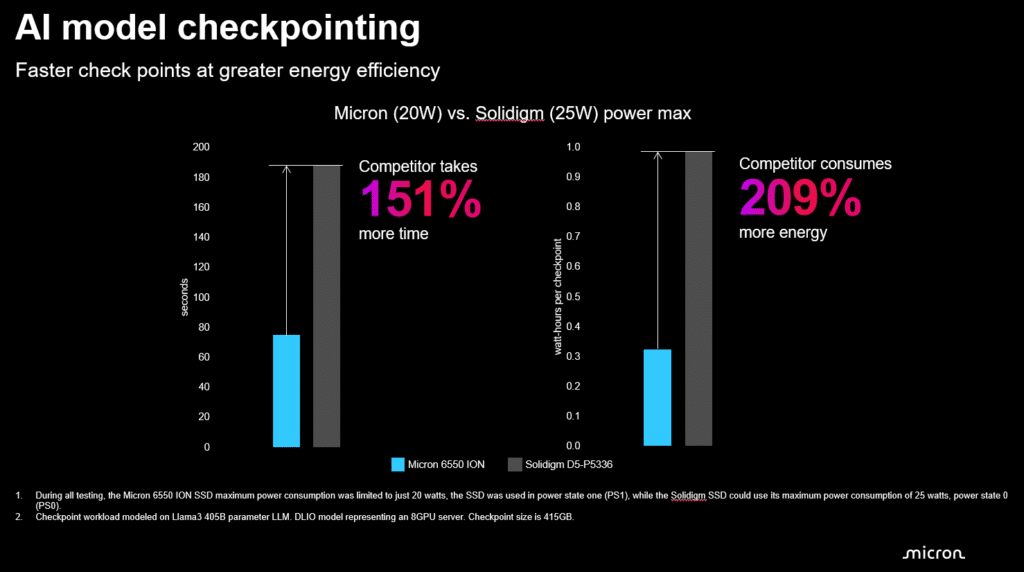
Conclusion
The move to Gen5 enterprise SSDs has given server designers more flexibility than ever regarding storage. The E3.S form factor opened the doors to extreme drive density. With the E3.S, standard 1U servers can hold 20 E3.S SSDs, compared with 8-10 U.2 drives. 2U servers enjoy similar advantages, supporting up to 32 (or more) E3.S SSDs vs 24 in a U.2 system. Interestingly, some server vendors, like Dell Technologies, went to E3.S as their only option for Gen5 storage, making the growth of the E3.S SSD ecosystem critical.
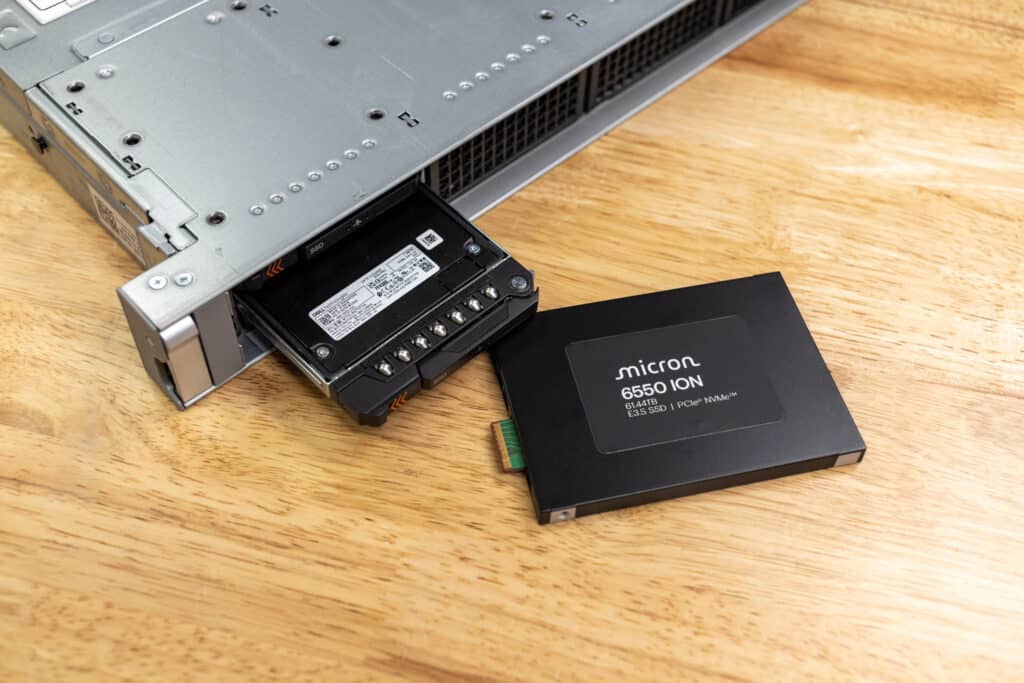
In our early performance testing, we validated performance claims by Micron on the 6550 ION. A crucial part of the 6550 ION launch is its power-to-performance profile. We limited the Micron 6550 ION to PS1 (or 20W maximum) and ran it through 16K random and 128K sequential workloads against the Solidigm P5336 to see how that stacked up. In 128K sequential read, we measured 12.7GB/s on the 6550 ION compared to 7.5GB/s on the Soldigim P5336. The TLC NAND in the Micron drive also has significant write performance benefits, which we found in our 16K random write workload. The Micron 6550 ION measured 84.5k IOPs compared to just 51.9k IOPs on the P5336.
In this testing, we compared the Micron 6550 ION to the only 61.44TB widely shipping today, the Solidigm P5336. It’s not an even match, but that’s also the point. Micron’s engineering team has sorted out how to jam an amazing amount of NAND into a 7.5mm drive enclosure while emphasizing power efficiency, performance, and cost-effectiveness. This early look at performance has us enthused about logging more hours on these drives to understand better how they perform in various applications.
This report is sponsored by Micron. All views and opinions expressed in this report are based on our unbiased view of the product(s) under consideration.




 Amazon
Amazon